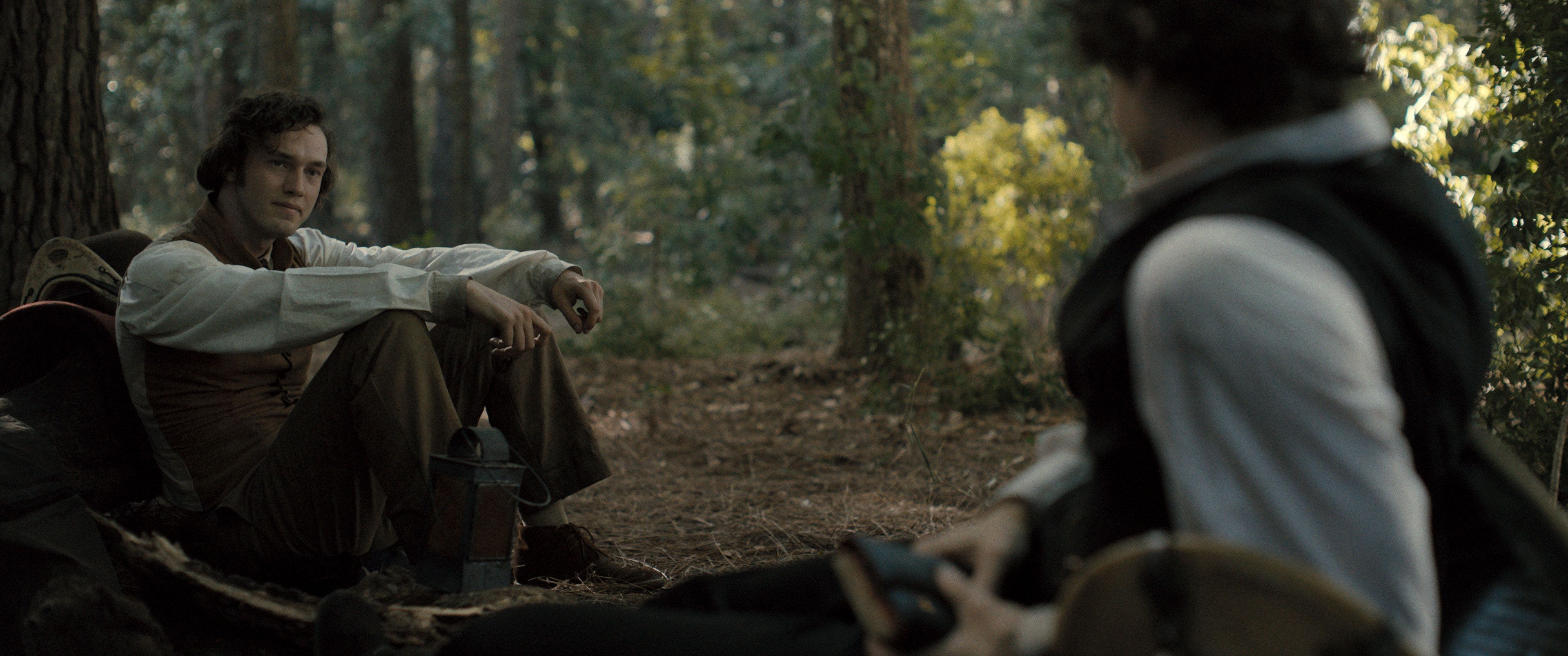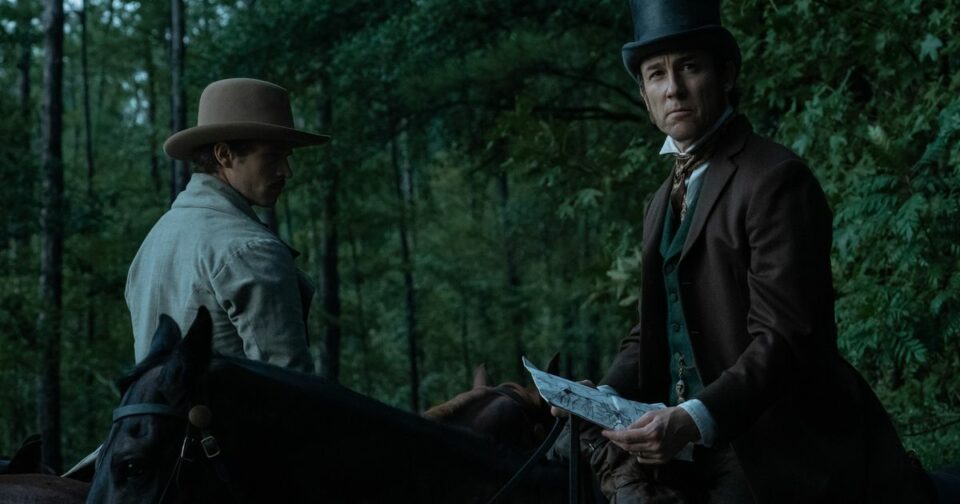
If it hadn’t been obvious before, it’s obvious now: John Wilkes Booth’s escape plan might have had some flaws. On paper, it would look something like this:
But the thing about getting to Richmond is you can’t keep losing your way and lopping back to Maryland. That’s the problem Booth and Herold face as “A Man of Destiny” opens, though the moments before the problem becomes apparent provide some telling insights into Booth’s character. He almost enlisted, but that kind of service to the cause wasn’t for him, in part because he didn’t dig the uniforms. That said, he’s prepared to accept a high-ranking position once he reaches his destination. It just makes sense. Yet once their situation becomes apparent, Booth decides to put on whatever uniform he needs to wear to survive.
The episode’s title could be a reference to Booth’s delusions or could refer to a new player on the Manhunt scene, an intense man introduced sitting in the rain. If you don’t want any spoilers, don’t look up the name “Boston Corbett,” played here by William Mark McCullough, though it’s not hard to figure out what role he’ll play in the story. Corbett’s a character who might seem too far-fetched if he didn’t really exist. That reference to him “slicing off his ball sack” because of God? True. (It’s even more grisly than that summary makes it sound.) Corbett also worked as a milliner, an occupation that, in the 19th century at least, involved exposure to occasionally mind-warping chemicals, hence the expression “mad as a hatter” (though Lewis Carroll wouldn’t invent the Mad Hatter until later in the century). Corbett, an Englishman who named himself after his new home, did lose his wife and found himself tortured by “base desires” and put himself into the hands of God. And God’s hands will soon take him to a fateful spot.
In Washington, other men are reshaping American history. After saying “I’m fond of the institution of slavery,” Andrew Johnson tries to sell his watered-down version of Reconstruction to some powerful Southerners. It doesn’t fly, particularly the land grants that give freed men and women a leg up in the post-war world. The look on Johnson’s face suggests the promise of 40 acres and a mule might not be a lasting one.
It’s hard to see Stanton going for this, but Stanton’s busy elsewhere, intensifying the search for Booth and Herold, whose advantage seems to be drying up. Booth’s leg isn’t getting any better, and Herold doesn’t know where he’s going, but they have reached Virginia, and those uniforms might help disguise them. After all, there are a lot of defeated Confederate soldiers wandering around. And though Stanton seems like the sort who would question every single one of them if he could, Johnson’s betrayal brings him back to Washington to fight.
It’s not the first time he’s championed land grants: Inspired by the petitions of the formerly enslaved, he made land grants a plank of Reconstruction and drew up a plan for coastal lands that made sense, even bringing General William Tecumseh Sherman (Alex Collins) to his side. It’s logistically possible and, beyond that, it’s fair and American. But Johnson’s not interested in any of that and, ultimately, Stanton agrees with Eckert that he should stick around to “temper Johnson’s worst instincts” rather than resign.
It’s the pragmatic choice, but a later scene in which Mary learns she has to give up the land that made her so proud illustrates how policy decisions can have devastating consequences on the ground. Left with nothing, she returns to Mudd in the hopes of reclaiming her job. Instead, she gets the promise he’ll “ruin” her and a beating that’s, mercifully, not depicted onscreen. As this happens, Mudd is on Stanton’s mind as well. New intel suggests that Booth already knew the doctor and where to head to have his injury treated.
This is, again, contrary to the depictions of Mudd as a good, misunderstood doctor, which still persists in the popular imagination. It also seems to be far closer to the facts of Mudd’s life. Mudd starts to fall apart under Stanton’s questioning even before a search turns up Booth’s monogrammed boot. This also opens up the opportunity for Mary to tell all she knows, earning Stanton’s thanks and directions to the Arlington camp where she and her brother might have the best shot at starting a new life, though without the land they were promised.
Meanwhile, Booth and Herold aren’t having an easy time of it. After taking shelter with a Black family, they hook up with a group of legitimate Confederate soldiers, one of whom immediately spots Booth as a phony. Called a coward, Booth decides to reveal himself as Lincoln’s killer. Loudly. And in front of a bunch of people. Booth lives to perform for an audience, no matter what the risk. So, it comes as a shock that the soldiers aren’t impressed with his deeds. Some, in fact, are repelled by them. It only takes one, however, to point them toward a “friendly” who can offer them shelter.
Jetting from here to the ferry crossing where Booth and Herold made their passage, Stanton receives a hot tip from a ferryman who witnessed Booth’s performance. One conversation with the man who pointed Booth toward a friendly, and Stanton’s off to the nearby Garrett farm, where a delirious Booth is being tended to by a comely farmer’s daughter who thinks he’s a hero. “Am I in heaven?” he asks. (Again, don’t Google “Booth Garrett farm” if you don’t want spoilers.) But, as the episode draws to a close, it looks like Stanton might not be well enough to make it to the finish line himself.
Codes and Clues
• This is another fine episode of Manhunt, albeit one in which it’s hard to ignore some of the structural creakiness that comes from trying to squeeze a lot of history into less than two weeks of story. Mary seems to receive her land grant, then lose it, then return to Mudd, then turn on Mudd in the course of a couple of days. In reality, the land grants created by Sherman’s Field Order No. 15, which would have provided land for about 40,000 Black Americans, were revoked in the fall of 1865, not April, days after Lincoln’s death. If anything, this makes it even more tragic, given the time it allowed for freed people to make plans for the future. But it’s also outside the scope of Manhunt’s timeline. Dramatically, it makes sense to depict it here. But it’s probably best not to think too hard about the condensed timeline, just as it’s best not to try to figure out how Stanton made it from the trail, back to Washington, on to Mudd’s farm, then back on the trail again so quickly.
• The idea of a Cabinet member sticking around to temper a president’s worst impulses sounds another note of contemporary resonance, doesn’t it?
By Keith Phipps , 2024-04-05 21:16:05
Source link
